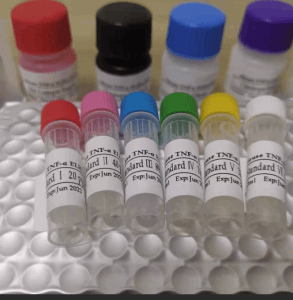丝/苏氨酸蛋白质激酶II α抗体
- 发布日期: 2025-03-19
- 更新日期: 2025-12-18
产品详请
| 产地 |
中国
|
| 品牌 |
雅吉生物
|
| 保存条件 |
-20
|
| 货号 |
YS-1607R
|
| 用途 |
|
| 应用范围 |
|
| 抗原来源 |
Rabbit
|
| 保质期 |
|
| 抗体名 |
|
| 是否单克隆 |
|
| 克隆性 |
否
|
| 靶点 |
详见説明
|
| 适应物种 |
Rabbit
|
| 形态 |
|
| 宿主 |
|
| 标记物 |
|
| 包装规格 |
50ul,100ul,200ul
|
| 亚型 |
IgG
|
| 标识物 |
|
| 浓度 |
1mg/ml%
|
| 免疫原 |
|
| 是否进口 |
|
英文名称Rabbit Anti-CK II alpha antibody
中文名称丝/苏氨酸蛋白质激酶II α抗体
别 名STK; Casein kinase II Alpha; CKII alpha; Serine/Threonine Protein Kinase II Alpha; CKⅡalpha; Casein kinase 2 alpha 1 polypeptide; Casein kinase II alpha 1 subunit; Casein kinase II alpha chain; Casein kinase II alpha subunit; Casein kinase II subunit alpha; Casein kinase II alpha 1; CK II alpha; CKIIalpha; CSK21_HUMAN; CK II; CK2 alpha; CK2 catalytic subunit alpha; CK2A1; CKII; CSNK2A1.;CK2α
抗体来源Rabbit
克隆类型Polyclonal
交叉反应Mouse,Rat (predicted: Human,Cow,Dog)
产品应用WB=1:500-2000
not yet tested in other applications.
optimal dilutions/concentrations should be determined by the end user.
理论分子量45kDa
细胞定位细胞核
性 状Liquid
浓 度1mg/ml
免 疫 原KLH conjugated synthetic peptide derived from human CK II alpha: 201-300/391
亚 型IgG
纯化方法affinity purified by Protein A
缓 冲 液0.01M TBS (pH7.4) with 1% BSA, 0.02% Proclin300 and 50% Glycerol.
保存条件Shipped at 4℃. Store at -20℃ for one year. Avoid repeated freeze/thaw cycles.
注意事项This product as supplied is intended for research use only, not for use in human, therapeutic or diagnostic applications.
PubMedPubMed
产品介绍Casein kinase II is a serine/threonine protein kinase that phosphorylates acidic proteins such as casein. The kinase exists as a tetramer and is composed of an alpha, an alpha-prime, and two beta subunits. The alpha subunits contain the catalytic activity while the beta subunits undergo autophosphorylation. The protein encoded by this gene represents the alpha subunit. While this gene is found on chromosome 20, a related transcribed pseudogene is found on chromosome 11. Three transcript variants encoding two different proteins have been found for this gene. [provided by RefSeq, Jul 2008]
Function:
Catalytic subunit of a constitutively active serine/threonine-protein kinase complex that phosphorylates a large number of substrates containing acidic residues C-terminal to the phosphorylated serine or threonine. Regulates numerous cellular processes, such as cell cycle progression, apoptosis and transcription, as well as viral infection. May act as a regulatory node which integrates and coordinates numerous signals leading to an appropriate cellular response. During mitosis, functions as a component of the p53/TP53-dependent spindle assembly checkpoint (SAC) that maintains cyclin-B-CDK1 activity and G2 arrest in response to spindle damage. Also required for p53/TP53-mediated apoptosis, phosphorylating 'Ser-392' of p53/TP53 following UV irradiation. Can also negatively regulate apoptosis. Phosphorylates the caspases CASP9 and CASP2 and the apoptotic regulator NOL3. Phosphorylation protects CASP9 from cleavage and activation by CASP8, and inhibits the dimerization of CASP2 and activation of CASP8. Regulates transcription by direct phosphorylation of RNA polymerases I, II, III and IV. Also phosphorylates and regulates numerous transcription factors including NF-kappa-B, STAT1, CREB1, IRF1, IRF2, ATF1, SRF, MAX, JUN, FOS, MYC and MYB. Phosphorylates Hsp90 and its co-chaperones FKBP4 and CDC37, which is essential for chaperone function. Regulates Wnt signaling by phosphorylating CTNNB1 and the transcription factor LEF1. Acts as an ectokinase that phosphorylates several extracellular proteins. During viral infection, phosphorylates various proteins involved in the viral life cycles of EBV, HSV, HBV, HCV, HIV, CMV and HPV. Phosphorylates PML at 'Ser-565' and primes it for ubiquitin-mediated degradation.
Subunit:
Heterotetramer composed of two catalytic subunits (alpha chain and/or alpha' chain) and two regulatory subunits (beta chains). The tetramer can exist as a combination of 2 alpha/2 beta, 2 alpha'/2 beta or 1 alpha/1 alpha'/2 beta subunits. Also part of a CK2-SPT16-SSRP1 complex composed of SSRP1, SUPT16H, CSNK2A1, CSNK2A2 and CSNK2B, which forms following UV irradiation. Interacts with RNPS1. Interacts with SNAI1. Interacts with PML (isoform PML-12).
Post-translational modifications:
Phosphorylated at Thr-344, Thr-360, Ser-362 and Ser-370 by CDK1 in prophase and metaphase and dephosphorylated during anaphase. Phosphorylation does not directly affect casein kinase 2 activity, but may contribute to its regulation by forming binding sites for interacting proteins and/or targeting it to different compartments.
Similarity:
Belongs to the protein kinase superfamily. Ser/Thr protein kinase family. CK2 subfamily.
Contains 1 protein kinase domain.
SWISS:
P68400
Gene ID:
1457

